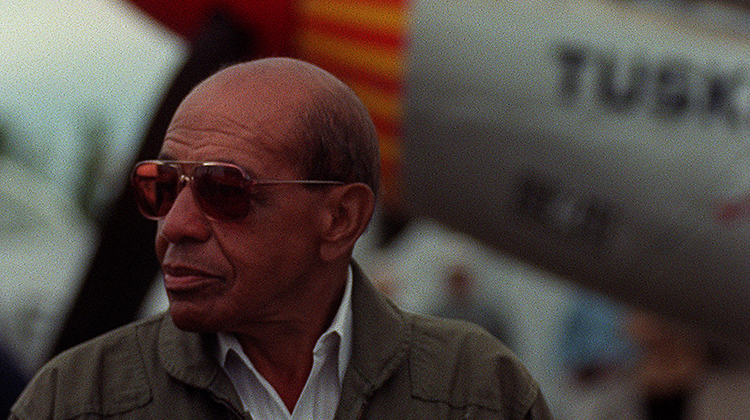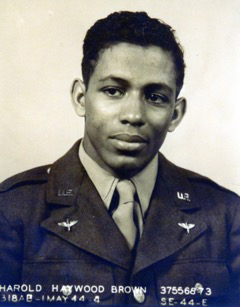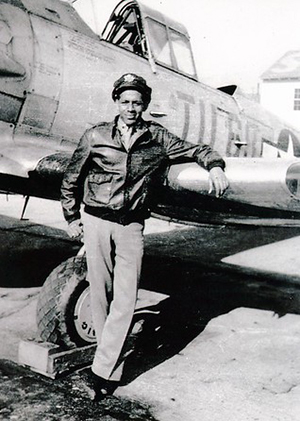
A 1965 graduate of Ohio University, Lt. Col. Harold Brown joined the 332nd Fighter Group – part of the history-making Tuskegee Airmen – in November 1944 and flew 30 missions in the European theater of World War II before being imprisoned in a POW camp in March 1945. Photo courtesy of Harold Brown
Among the treasures housed in Ohio University’s Alden Library is the Cornelius Ryan Collection of World War II Papers , complete with all of the documents the world-renowned war correspondent used in writing the books, turned into movies, that chronicle the battles and the people who made world history.
This past June, in honor of the 75 th anniversary of D-Day, Iron Mountain Incorporated announced a gift-in-kind service to support Alden Library’s efforts to digitize the Cornelius Ryan Collection , partnering with OHIO to preserve and make more accessible these written portals to the past for future generations.
Inspired by Ryan and in honor of Veterans Day, Ohio Today News caught up with an Ohio University graduate whose role in World War II and American history is as unique as his OHIO experience.
Lt. Col. Harold Brown, BA ’65, wasn’t part of the wave of World War II veterans who enrolled at Ohio University with the help of the GI Bill in the years immediately following the war. Those years saw OHIO’s enrollment rise more than 300 percent, necessitating the construction of barracks-style housing known as “Hog Island,” which later became the Athens Campus’ East Green.
A self-described “snotty-nosed high school graduate,” Brown was one of 15 new pilots to join the 332 nd Fighter Group – part of the famed Tuskegee Airmen – in November 1944.

Tuskegee Airman Harold Brown’s 23 years in the military included serving in World War II, in the Korean War and in the Strategic Air Command during the Cold War. Photo courtesy of Harold Brown
The Tuskegee Airmen were the first African American fighter group to serve in the Army Air Corps, and Brown was one of 355 of the American heroes who saw combat in the sky during World War II. They fought in an Army that was still segregated, battling the enemy abroad with prejudice awaiting them when they returned home, and paved the way for the desegregation of the U.S. military in 1948 and the civil rights movement.
As a member of the 332 nd Fighter Group, Brown flew P-51 Mustang fighters in the European theater of World War II. He had already flown 29 missions when, in March 1945, his plane was hit by debris from an exploding train that he had been exchanging gunfire with.
In his 2017 book, “Keep Your Airspeed Up: The Story of a Tuskegee Airman,” Brown recounts that day when he ejected from his failing plane, faced the real possibility of being hung by an angry German mob, and was imprisoned in a POW camp where he spent two months before being liberated by U.S. forces.
Brown returned home to a country no longer bound to the fear of a world controlled by Axis powers; however, the heroism of the Tuskegee Airmen went largely unnoticed for decades. He remained in the Air Corps, serving in the Korean War and in the Strategic Air Command during the Cold War.
Despite nearly giving his life in service to his country, Brown always worried about his future after the military.
“I knew there would eventually be a reduction in force, and I thought what’s so special about me that I won’t be one of the first ones to get cut because I had almost nothing to offer,” he said. “Fighter pilots were a dime a dozen, and uneducated ones were worth even less than that.”
Brown began developing his work ethic at age 12 when he took his first job delivering newspapers.
“From the day that I started that job, I liked to brag that I was never without a dime in my pocket for the rest of my life. I always had money in my pocket because I always had a job,” he said.
That work ethic continued throughout the 20 years he spent in the military following World War II. No matter where he was stationed, Brown would seek out colleges in the area to see if they offered night courses, studying math at institutions both overseas and at home.
His last assignment in the military brought him to Lockbourne Air Force Base in Columbus – now known as the Rickenbacker Air National Guard Base – and to Ohio University.
A flight instructor who was just a few credits shy of graduating, Brown found that Ohio University was offering the courses he needed to finally earn his college degree, but with one hurdle. He worked the day shift at the base, which conflicted with the time those classes were offered, so he approached his colleagues in the command post with an offer they couldn’t refuse.
“I traded shifts with them,” Brown said. “I took all their night shifts for the whole year.”
Brown spent the next year working 12-hour shifts from 7 p.m. to 7 a.m. Then he’d drive to Athens, take classes from 8 a.m. to 3 p.m., drive back to Columbus – often with the car’s windows rolled down to help keep him awake – sneak in a few hours of sleep, and then start the routine all over again.

Lt. Col. Harold Brown graduated from Ohio University in June 1965, just days after retiring from the Army on May 31, 1965, having logged more than 6,500 hours in the sky. Photo courtesy of Harold Brown
“For my last two semesters, that’s what I did,” he said. “I took classes in engineering physics, which were some of the most rigorous classes I ever took.”
Brown credited the chair of OHIO’s physics department with seeing in him the determination to succeed in the tough coursework.
“He said, ‘If you’re willing to drive all the way down here and go through all of that, then I’ll let you into the program,’” Brown recalled. “He understood my situation and said, ‘You’re a glutton for punishment. I’ll tell you right now you’re going to have to work hard.’”
Working the night shifts at Lockbourne afforded Brown some time to study, and on his days off, he went to work as an instructor pilot.
“That was perhaps one of the most difficult years I had in my military career – primarily because I just wasn’t getting that much sleep,” Brown said. “But I went on. I toughed it out, and I graduated.”
Brown graduated from Ohio University in June 1965, just days after retiring from the Army on May 31, 1965, having logged more than 6,500 hours in the sky.
His busy schedule meant that Brown didn’t have much time to enjoy the aspects of college life that many of his fellow Bobcats did, but he was captivated by his OHIO experience, nonetheless.
“I saw enough of the campus to know one thing: OU in Athens was the best place in the world to have a college,” he said. “It was nice. It was a swinging place. And I can remember those college kids – yeah, they were working hard, but they were sure having a lot of fun. I’ve often thought if I would have gone to college for four years, that’s just the place I would have liked to have been. I just liked the atmosphere.”
After fulfilling the promise he made himself to earn his college degree, it’s not surprising that Brown went on to earn his doctoral degree and to embark on a second career – in higher education. He was hired to teach in the math department at the Columbus Technical Institute, which was just starting out in the basement of Central High School and today is known as Columbus State Community College. In his first quarter with the institution, he was approached with a new opportunity in the college’s electronics department.
“The director of the school came up to me, and he knew my background because he had offered me the job. He said ‘Harold, you ran an electronics department over in Japan. Can you take over the department and make it run?’,” Brown recalled. “I said, ‘Sure I can.’”
When Brown retired in 1986, he was the institution’s vice president of academic affairs.
Today, the 95-year-old resides in Port Clinton, Ohio, with his wife and co-author of his book, Marsha. One of the last living Tuskegee Airmen, Brown continues to be recognized for his historic and heroic service in World War II – service that saved the world and changed a nation. Brown was honored at the 2018 American Veterans Center’s 21 st Annual Veterans Conference, and next April he will be inducted into the Minnesota Aviation Hall of Fame.
Disclaimer: It is not the intent of Ohio University to imply an endorsement by any service branch of the U.S. Armed Forces.

